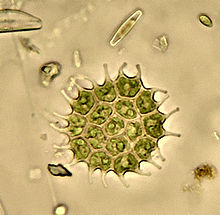Hydrodictyaceae
| Hydrodictyaceae | |
|---|---|

| |
| Pediastrum | |
| Scientific classification | |
| Clade: | Viridiplantae |
| Division: | Chlorophyta |
| Class: | Chlorophyceae |
| Order: | Sphaeropleales |
| Family: | Hydrodictyaceae Dumortier, 1829 |
| Genera[1] | |
|
See text | |
Hydrodictyaceae is a family of green algae in the order Sphaeropleales.[1] They are found in freshwater habitats worldwide.[2]
Members of this family are either unicellular or colonial. Cells are cylindrical, polyhedral, spherical, or sometimes nearly spherical. Cells contain a single parietal, chloroplast with a pyrenoid.[3] The cell wall may be smooth or covered in warts, ribs or other ornamentation.[4]
Reproduction can occur asexually or sexually. In asexual reproduction, the mother cell becomes a number of zoospores and swim inside the enlarged mother cell wall, until they attach to each other and become a new colony. In Tetraedron, the cells do not produce zoospores but produce autospores within the enlarged mother cell wall. Sexual reproduction, when observed, occurs via isogamous gametes.[2]
Because the cell wall of some Hydrodictyaceae contain sporopollenin, they decay very slowly and thus last long in the fossil record.[5]
Genera
[edit]The family Hydrodictyaceae includes the following genera:[1]
- Euastropsis
- Helierella
- Hydrodictyon
- †Hydrodictyopsis
- Lacunastrum
- Monactinus
- Parapediastrum
- †Pediastrites
- Pediastrum
- Pseudopediastrum
- Sorastrum
- Sphaerastrum
- Stauridium
- Tetraedroides
- Tetraedron
- Tetrapedia
Traditionally, the genus Tetraedron was excluded and placed within the Chlorellaceae, because of autospore formation.[2] However, the genus produces autospores within an enlarged cell wall, similar to Pediastrum, and molecular phylogenetic evidence shows that they are related.[2]
Molecular phylogenetic studies suggest the following relationships (not all genera are included):[2][6][7][8]
| Hydrodictyaceae |
| ||||||||||||||||||||||||||||||||||||||||||
|
Neochloridaceae (outgroup) | |||||||||||||||||||||||||||||||||||||||||||
References
[edit]- ^ a b c Guiry, M.D.; Guiry, G.M. "Hydrodictyaceae". AlgaeBase. University of Galway. Retrieved 2024-11-29.
- ^ a b c d e Buchheim, Mark; Buchheim, Julie; Carlson, Tracy; Braband, Anke; Hepperle, Dominik; Krienitz, Lothar; Wolf, Matthias; Hegewald, Eberhard (2005). "Phylogeny of the Hydrodictyaceae (Chlorophyceae): Inferences from rDNA Data". Journal of Phycology. 41 (5): 1039–1054. Bibcode:2005JPcgy..41.1039B. doi:10.1111/j.1529-8817.2005.00129.x. S2CID 83698514.
- ^ Philipose, M.T. (1967). Chlorococcales. New Delhi: Indian Council of Agricultural Research. pp. 1–365.
- ^ Komárek, J.; Fott, B. (1983). Chlorophyceae (Grünalgen), Ordnung Chlorococcales. Das Phytoplankton des Süßwassers (in German). E. Schweizerbart'sche Verlagsbuchhandlung. p. 1044.
- ^ Komárek, Jirí; Jankovská, Vlasta (2001). Review of the Green Algal Genus Pediastrum; Implication for Pollen-analytical Research. Bibliotheca Phycologica. Schweizerbart Science Publishers. p. 127. ISBN 978-3-443-60035-8.
- ^ Jena, Mrutyunjay; Bock, Christina; Behera, Chhandashree; Adhikary, Siba P.; Krienitz, Lothar (2014). "Strain survey on three continents confirms the polyphyly of the genus Pediastrum (Hydrodictyaceae, Chlorophyceae)". Fottea. 14: 63–76. doi:10.5507/fot.2014.005.
- ^ McManus, Hilary A.; Lewis, Louise A. (2011). "Molecular phylogenetic relationships in the freshwater family Hydrodictyaceae (Sphaeropleales, Chlorophyceae), with an emphasis on Pediastrum duplex 1". Journal of Phycology. 47 (1): 152–163. Bibcode:2011JPcgy..47..152M. doi:10.1111/j.1529-8817.2010.00940.x. PMID 27021721.
- ^ McManus, Hilary A.; Fučíková, Karolina; Lewis, Paul O.; Lewis, Louise A.; Karol, Kenneth G. (2018). "Organellar phylogenomics inform systematics in the green algal family Hydrodictyaceae (Chlorophyceae) and provide clues to the complex evolutionary history of plastid genomes in the green algal tree of life". American Journal of Botany. 105 (3): 315–329. doi:10.1002/ajb2.1066. PMID 29722901.
